初中英语 原因、目的和结果状语从句详解
- 格式:pptx
- 大小:90.27 KB
- 文档页数:13
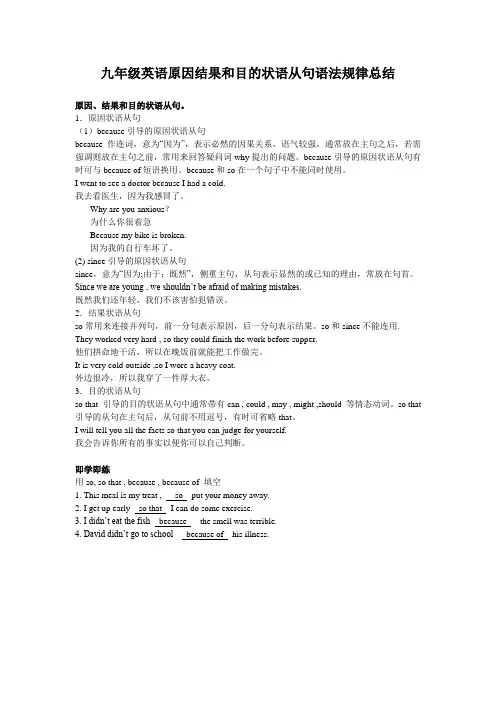
九年级英语原因结果和目的状语从句语法规律总结原因、结果和目的状语从句。
1.原因状语从句(1)because引导的原因状语从句because作连词,意为“因为”,表示必然的因果关系,语气较强,通常放在主句之后,若需强调则放在主句之前,常用来回答疑问词why提出的问题。
because引导的原因状语从句有时可与because of短语换用。
because和so在一个句子中不能同时使用。
I went to see a doctor because I had a cold.我去看医生,因为我感冒了。
-Why are you anxious?-为什么你很着急-Because my bike is broken.-因为我的自行车坏了。
(2) since引导的原因状语从句since,意为“因为;由于;既然”,侧重主句,从句表示显然的或已知的理由,常放在句首。
Since we are young , we shouldn’t be afraid of making mistakes.既然我们还年轻,我们不该害怕犯错误。
2.结果状语从句so常用来连接并列句,前一分句表示原因,后一分句表示结果。
so和since不能连用. They worked very hard , so they could finish the work before supper.他们拼命地干活,所以在晚饭前就能把工作做完。
It is very cold outside ,so I wore a heavy coat.外边很冷,所以我穿了一件厚大衣。
3.目的状语从句so that 引导的目的状语从句中通常带有can , could , may , might ,should 等情态动词。
so that 引导的从句在主句后,从句前不用逗号,有时可省略that。
I will tell you all the facts so that you can judge for yourself.我会告诉你所有的事实以便你可以自己判断。
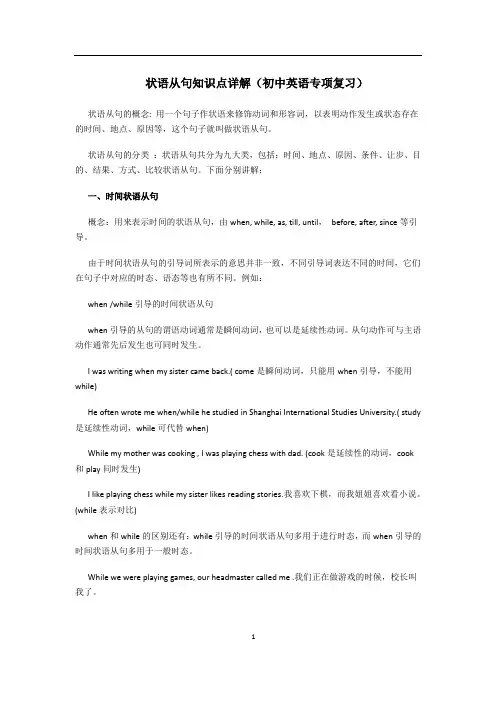
状语从句知识点详解(初中英语专项复习)状语从句的概念: 用一个句子作状语来修饰动词和形容词,以表明动作发生或状态存在的时间、地点、原因等,这个句子就叫做状语从句。
状语从句的分类:状语从句共分为九大类,包括:时间、地点、原因、条件、让步、目的、结果、方式、比较状语从句。
下面分别讲解:一、时间状语从句概念:用来表示时间的状语从句,由when, while, as, till, until,before, after, since等引导。
由于时间状语从句的引导词所表示的意思并非一致,不同引导词表达不同的时间,它们在句子中对应的时态、语态等也有所不同。
例如:when /while引导的时间状语从句when引导的从句的谓语动词通常是瞬间动词,也可以是延续性动词。
从句动作可与主语动作通常先后发生也可同时发生。
I was writing when my sister came back.( come是瞬间动词,只能用when引导,不能用while)He often wrote me when/while he studied in Shanghai International Studies University.( study 是延续性动词,while可代替when)While my mother was cooking , I was playing chess with dad. (cook是延续性的动词,cook和play同时发生)I like playing chess while my sister likes reading stories.我喜欢下棋,而我姐姐喜欢看小说。
(while表示对比)when和while的区别还有:while引导的时间状语从句多用于进行时态,而when引导的时间状语从句多用于一般时态。
While we were playing games, our headmaster called me .我们正在做游戏的时候,校长叫我了。
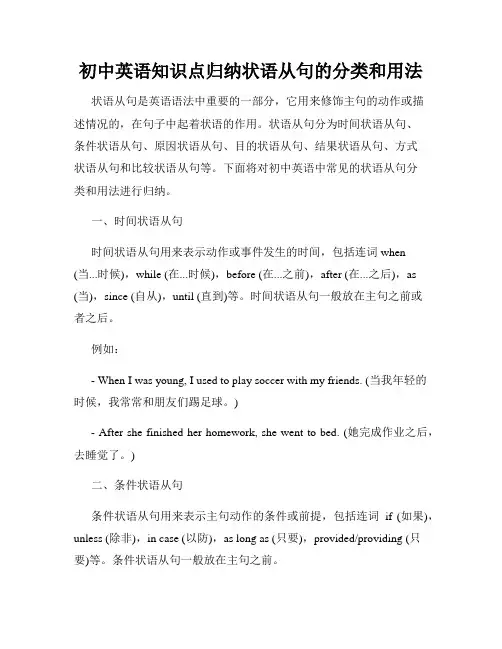
初中英语知识点归纳状语从句的分类和用法状语从句是英语语法中重要的一部分,它用来修饰主句的动作或描述情况的,在句子中起着状语的作用。
状语从句分为时间状语从句、条件状语从句、原因状语从句、目的状语从句、结果状语从句、方式状语从句和比较状语从句等。
下面将对初中英语中常见的状语从句分类和用法进行归纳。
一、时间状语从句时间状语从句用来表示动作或事件发生的时间,包括连词when (当...时候),while (在...时候),before (在...之前),after (在...之后),as (当),since (自从),until (直到)等。
时间状语从句一般放在主句之前或者之后。
例如:- When I was young, I used to play soccer with my friends. (当我年轻的时候,我常常和朋友们踢足球。
)- After she finished her homework, she went to bed. (她完成作业之后,去睡觉了。
)二、条件状语从句条件状语从句用来表示主句动作的条件或前提,包括连词if (如果),unless (除非),in case (以防),as long as (只要),provided/providing (只要)等。
条件状语从句一般放在主句之前。
例如:- If it rains tomorrow, we will stay at home. (如果明天下雨,我们就在家呆着。
)- Unless you work hard, you won't pass the exam. (除非你努力学习,否则你就不能通过考试。
)三、原因状语从句原因状语从句用来表示主句动作或情况的原因,包括连词because (因为),as (因为),since (因为),for (因为),now that (既然)等。
原因状语从句一般放在主句之前。
例如:- Because it was raining, we stayed at home. (因为下雨,我们呆在家里。
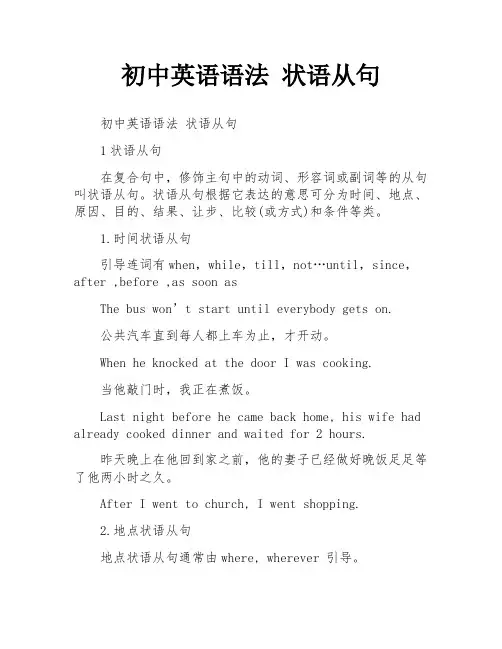
初中英语语法状语从句初中英语语法状语从句1状语从句在复合句中,修饰主句中的动词、形容词或副词等的从句叫状语从句。
状语从句根据它表达的意思可分为时间、地点、原因、目的、结果、让步、比较(或方式)和条件等类。
1.时间状语从句引导连词有when,while,till,not…until,since,after ,before ,as soon asThe bus won’t start until everybody gets on.公共汽车直到每人都上车为止,才开动。
When he knocked at the door I was cooking.当他敲门时,我正在煮饭。
Last night before he came back home, his wife had already cooked dinner and waited for 2 hours.昨天晚上在他回到家之前,他的妻子已经做好晚饭足足等了他两小时之久。
After I went to church, I went shopping.2.地点状语从句地点状语从句通常由where, wherever 引导。
Where there is a will, there is a way. 哪里有志向,哪里就有出路。
有志者事竟成。
Where there is a life, there is a hope. 哪里有生命,哪里就有希望。
留得青山在,不怕没柴烧。
Wherever you go, whatever you do, I will be right here waiting for you.不管你去哪里,不管你做什么,我都会在此守侯你。
3.原因状语从句引导连词有because,as, since。
He didn′t see the film because he had seen it.他没有看那部电影,因为他已经看过了。
They couldn’t get on the train,for it was too crowed.比较:because, since, as和for1)because语势最强,用来说明人所不知的原因,回答why提出的问题。

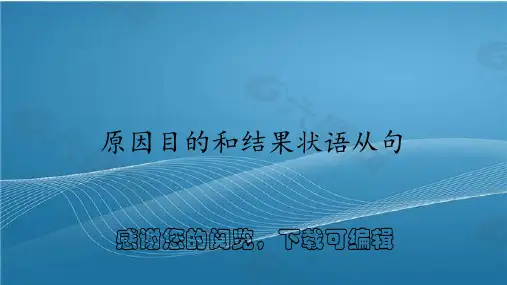

初中英语语法三大从句在初中英语中,主要有三大从句,即宾语从句、定语从句、状语从句(包括时间、条件、结果、目的、原因、让步、地点、方式等)。
小编今天跟大家分享的就是这三个从句的主要语法点,赶快看起来吧!初中英语语法三大从句宾语从句一、定义在句子中起宾语作用的从句叫做宾语从句。
二、连接词that: I think that you can pass the exam.Whether/if: I don’t know what the word means.“Wh”: I don’t know what the word means.I don’t know where he found the book.只用whether的情况:1. 与or not连用:I don’t know whether it’s raining or not.2. 与动词不定式连用:He doesn’t know whether to accept the invit ation.3. 连接词前有介词时:It depends on whether he is coming.三、时态1. 主句是一般现在时态,从句根据实际情况而定(各种时态均可)She wants to know what he has done for the exam.2.主句是一般过去时态,从句用相应的过去的时态。
1)She said that she was a student.2)She said that she would fly to Japan in a week.3)She said that she had finished her homework already.3. 如果宾语从句说的是客观真理、自然现象或事实时,这时宾语从句要用一般现在时态。
The teacher said that the earth goes round the sun.定语从句一、定义在复合句中修饰名词、代词的从句叫定语从句。
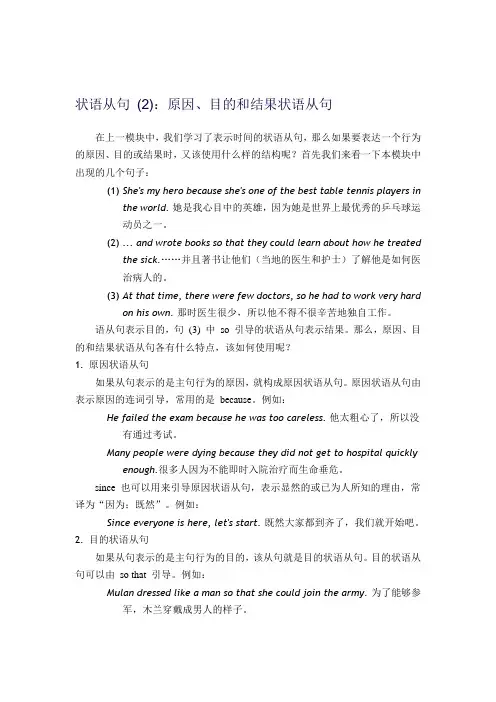
状语从句(2):原因、目的和结果状语从句在上一模块中,我们学习了表示时间的状语从句,那么如果要表达一个行为的原因、目的或结果时,又该使用什么样的结构呢?首先我们来看一下本模块中出现的几个句子:(1) She's my hero because she's one of the best table tennis players inthe world. 她是我心目中的英雄,因为她是世界上最优秀的乒乓球运动员之一。
(2) ... and wrote books so that they could learn about how he treatedthe sick.……并且著书让他们(当地的医生和护士)了解他是如何医治病人的。
(3) At that time, there were few doctors, so he had to work very hardon his own. 那时医生很少,所以他不得不很辛苦地独自工作。
语从句表示目的,句(3) 中so 引导的状语从句表示结果。
那么,原因、目的和结果状语从句各有什么特点,该如何使用呢?1. 原因状语从句如果从句表示的是主句行为的原因,就构成原因状语从句。
原因状语从句由表示原因的连词引导,常用的是because。
例如:He failed the exam because he was too careless. 他太粗心了,所以没有通过考试。
Many people were dying because they did not get to hospital quickly enough.很多人因为不能即时入院治疗而生命垂危。
since 也可以用来引导原因状语从句,表示显然的或已为人所知的理由,常译为“因为;既然”。
例如:Since everyone is here, let's start. 既然大家都到齐了,我们就开始吧。
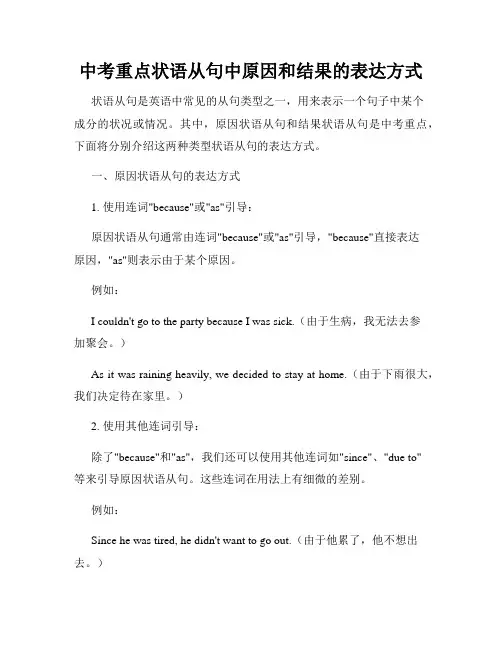
中考重点状语从句中原因和结果的表达方式状语从句是英语中常见的从句类型之一,用来表示一个句子中某个成分的状况或情况。
其中,原因状语从句和结果状语从句是中考重点,下面将分别介绍这两种类型状语从句的表达方式。
一、原因状语从句的表达方式1. 使用连词"because"或"as"引导:原因状语从句通常由连词"because"或"as"引导,"because"直接表达原因,"as"则表示由于某个原因。
例如:I couldn't go to the party because I was sick.(由于生病,我无法去参加聚会。
)As it was raining heavily, we decided to stay at home.(由于下雨很大,我们决定待在家里。
)2. 使用其他连词引导:除了"because"和"as",我们还可以使用其他连词如"since"、"due to"等来引导原因状语从句。
这些连词在用法上有细微的差别。
例如:Since he was tired, he didn't want to go out.(由于他累了,他不想出去。
)Due to the bad weather, the match was canceled.(由于天气不好,比赛被取消了。
)3. 句型倒装:在原因状语从句中,为了强调或使句子结构更复杂而运用了部分倒装的情况也是很常见的。
例如:Not until he finished his homework did he go to bed.(直到他完成作业,他才去睡觉。
)Only when she saw the exam paper did she realize she had made many mistakes.(直到她看到试卷,她才意识到自己犯了许多错误。
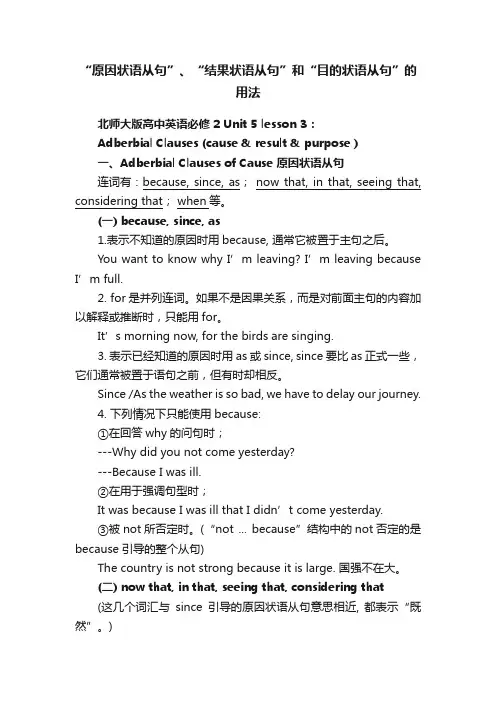
“原因状语从句”、“结果状语从句”和“目的状语从句”的用法北师大版高中英语必修2 Unit 5 lesson 3:Adberbial Clauses (cause & result & purpose )一、Adberbial Clauses of Cause原因状语从句连词有:because, since, as; now that, in that, seeing that, considering that; when等。
(一) because, since, as1.表示不知道的原因时用because, 通常它被置于主句之后。
You want to know why I’m leaving? I’m leaving because I’m full.2. for是并列连词。
如果不是因果关系,而是对前面主句的内容加以解释或推断时,只能用for。
It’s morning now, for the birds are singing.3. 表示已经知道的原因时用as或since, since要比as正式一些,它们通常被置于语句之前,但有时却相反。
Since /As the weather is so bad, we have to delay our journey.4. 下列情况下只能使用because:①在回答why的问句时;---Why did you not come yesterday?---Because I was ill.②在用于强调句型时;It was because I was ill that I didn’t come yesterday.③被not所否定时。
(“not ... because”结构中的not否定的是because引导的整个从句)The country is not strong because it is large. 国强不在大。
(二) now that, in that, seeing that, considering that(这几个词汇与since引导的原因状语从句意思相近, 都表示“既然”。
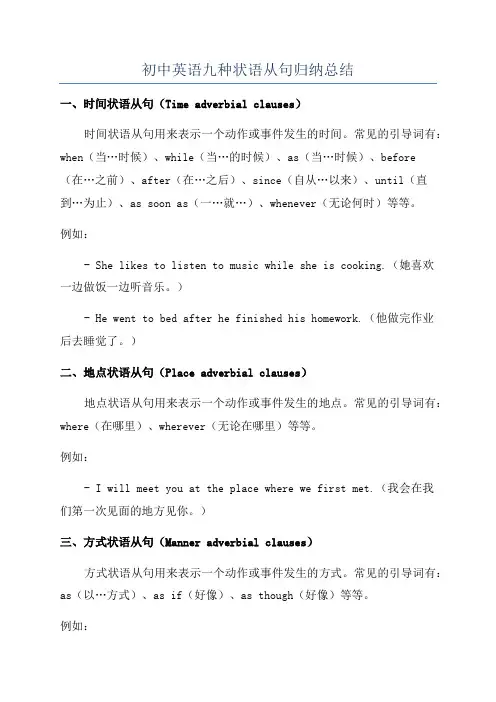
初中英语九种状语从句归纳总结一、时间状语从句(Time adverbial clauses)时间状语从句用来表示一个动作或事件发生的时间。
常见的引导词有:when(当…时候)、while(当…的时候)、as(当…时候)、before (在…之前)、after(在…之后)、since(自从…以来)、until(直到…为止)、as soon as(一…就…)、whenever(无论何时)等等。
例如:- She likes to listen to music while she is cooking.(她喜欢一边做饭一边听音乐。
)- He went to bed after he finished his homework.(他做完作业后去睡觉了。
)二、地点状语从句(Place adverbial clauses)地点状语从句用来表示一个动作或事件发生的地点。
常见的引导词有:where(在哪里)、wherever(无论在哪里)等等。
例如:- I will meet you at the place where we first met.(我会在我们第一次见面的地方见你。
)三、方式状语从句(Manner adverbial clauses)方式状语从句用来表示一个动作或事件发生的方式。
常见的引导词有:as(以…方式)、as if(好像)、as though(好像)等等。
例如:- She sang the song as if she was performing on stage.(她唱歌的时候好像在舞台上表演一样。
)- He spoke English as though he was a native speaker.(他讲英语好像是母语一样。
)四、原因状语从句(Reason adverbial clauses)原因状语从句用来表示一个动作或事件发生的原因。
常见的引导词有:because(因为)、as(因为)、since(因为)、as long as(只要)等等。
初中英语知识点归纳状语从句的条件与目的状语从句是英语语法中的一个重要部分,它可以用来说明某个行为、事件或状态的条件和目的。
在初中英语学习中,学生们需要掌握状语从句的使用方法和相应的条件与目的关系。
本文将对初中英语知识点中的状语从句的条件与目的进行归纳总结。
1. 条件状语从句(Adverbial Clauses of Condition)条件状语从句用来表示某个条件下产生的结果。
常用的引导词有:if(如果)、unless(除非)、as long as(只要)、as soon as(一……就)、provided that(倘若)、unless(除非)、in case(万一)等。
例如:- You can go out to play if you finish your homework.(如果你完成了作业,你可以出去玩。
)- We will succeed as long as we work hard.(只要我们努力工作,我们就会成功。
)- She won't pass the exam unless she studies harder.(除非她更加努力学习,否则她不会通过考试。
)在条件状语从句中,主句与从句之间通常采用逗号分隔,且从句使用陈述语序。
2. 目的状语从句(Adverbial Clauses of Purpose)目的状语从句用来表示某个行为或目的的目的或意图。
常用的引导词有:so that(为了)、in order that(为了)、to(为了)等。
例如:- We study hard so that we can get good grades.(我们努力学习,为的是能够取得好成绩。
)- He wears a coat in order that he can keep warm.(为了保暖,他穿上了外套。
)- They got up early to catch the first train.(他们早起是为了赶上第一班火车。
英语状语从句的讲解和例子英语状语从句的讲解和例子状语从句是一种从句,它位于句子的其他成分之前,作状语,表示时间、原因、条件、让步、结果、目的、方式、比较等意义。
状语从句中的动词要用陈述句语序,即谓语动词用一般现在时,谓语动词变成主语前有任何插入语时,谓语动词用一般过去时。
1、时间状语从句时间状语从句的关联词有:when,while,as,before,after,since,until,as soon as,hardly…when,no sooner…than,the moment,as long as,whenever等。
例句:1) I will go there when I finish my work.2) We had scarcely arrived when it started to rain.2、原因状语从句原因状语从句的关联词有:as,because,since,now that,for,in that,inasmuch as,as if,as long as,where(as)等。
例句:1) I can't go out because I have to finish my homework.2) As he was ill, he couldn't go to school.3、条件状语从句条件状语从句的关联词有:if,unless,only if,provided(that),supposing(that),in case,on condition(that),even if,so longas等。
例句:1) If it rains tomorrow, we won't go out.2) I will finish the work even if it takes me all night.4、让步状语从句让步状语从句的关联词有:though,although,while,whereas,no matter(how),whatever,regardless(of)等。
初中英语语法专练—原因、结果和目的状语从句-全考点详解一、状语从句状语从句是指在整句中作状语时,起副词作用的句子。
它可以修饰谓语、非谓语动词、定语、状语或整个句子。
根据其作用可分为时间、地点、原因、条件、目的、结果、让步、方式和比较等从句。
状语从句一般由连词(从属连词)引导,也可以由词组引起。
二、原因状语从句如果从句表示的是主句行为的原因,就构成原因状语从句。
原因状语从句由表示原因的连词引导,常用的有because,since,as等。
1.because引导的原因状语从句,表示的往往是读者不了解的、不明显的原因,是全句叙述的重点,语气最强。
because引导的原因状语从句既可以放在主句之前,用逗号隔开,也可以放在主句之后。
如:He failed the exam because he was too careless.2.since引导的原因状语从句,表示显然的或已为人知的理由,常译为"因为;既然"。
如:Since everyone is here,let's start our meeting.3.as引导的原因状语从句,意为"因为;由于",其语气不如because 强,通常为附加说明的理由,且是已知晓的原因,主句与从句没有逻辑上的因果关系。
如:As she wasn't well, I went there alone.三、结果状语从句如果从句表示的是主句行为的结果,就构成结果状语从句。
结果状语从句由表示结果的连词引导,常用的有so,so...that...,such...that...等。
1.so引导的结果状语从句,表示"由于某个行为而导致的结果",只能放在主句之后。
如:He worked too hard, so he fell ill again.注意:because和so不能同时用在一个句子里。
如:Because it rained heavily, we stayed at home./It rained heavily, so we stayed at home.2.so...that...引导的结果状语从句,意为"太......以致于......",so后面接形容词或副词(看so前面的词来决定用形容词还是副词,如果是系动词就用形容词;如果是行为动词,就用副词。
初中英语原因目的和结果状语从句详解原因状语从句(Adverbial clause of reason)是表示一个动作或情况的原因或理由的从句。
目的状语从句(Adverbial clause of purpose)是表示一个动作或情况的目的或意图的从句。
结果状语从句(Adverbial clause of result)是表示一个动作或情况的结果或后果的从句。
详细解释如下:1. 原因状语从句(Adverbial clause of reason):原因状语从句回答“为什么?”的问题,说明动作或情况的原因或理由。
原因状语从句通常由连词because、since、as、now that、seeing that等引导。
例句:- I couldn't sleep because it was too noisy.(我不能入睡,因为太吵了。
)- Since it was raining heavily, we stayed indoors.(由于下着大雨,我们呆在室内。
)2. 目的状语从句(Adverbial clause of purpose):目的状语从句回答“为了什么?”的问题,说明动作或情况的目的或意图。
目的状语从句通常由连词so that、in order that、for the purpose of等引导。
例句:- I study hard so that I can get good grades.(我努力学习,以便能取得好成绩。
)- I bought a ticket for the concert so that I could see my favorite singer.(我买了一张音乐会的票,为了能看到我最喜欢的歌手。
)3. 结果状语从句(Adverbial clause of result):结果状语从句回答“怎么样?”的问题,说明动作或情况的结果或后果。
结果状语从句通常由连词so、such...that、enough等引导。
状语从句目的与结果状语从句是从句中的一种,它用来修饰或补充主句中的谓语动词,以表达目的、结果、原因等关系。
本文将重点讨论状语从句的目的与结果。
一、目的状语从句目的状语从句用来表示某种行为或者动作的目的或意图。
它通常由连词“为了”、“以便”、“为了使”等引导。
下面通过两个例句来说明:1. 他学习努力,为了能够考上理想的大学。
他学习努力,目的是为了能够考上理想的大学。
2. 我们要节约用水,以便保护环境。
我们要节约用水,目的是以便保护环境。
通过以上两个例句可以看出,目的状语从句在句子中起到了修饰主句的作用,准确地表达了行为的目的。
这种句型在日常生活以及各种文体中都被广泛应用。
二、结果状语从句结果状语从句用来表示某个动作或者行为的结果。
它通常由连词“以至于”、“结果是”、“结果”,等引导。
下面通过两个例句来说明:1. 他笑得很开心,以至于眼泪都流出来了。
他笑得很开心,结果是眼泪都流出来了。
2. 大雨一直下,结果导致了道路积水严重。
大雨一直下,结果是导致了道路积水严重。
通过以上两个例句可以看出,结果状语从句能够完整地表达行为或者动作的结果,使句子更加具体生动。
总结:状语从句是语法结构中常见的一种句式,它能够表达目的或结果等关系。
通过目的状语从句可以准确地表达出某种行为的目的或意图,起到了修饰主句的作用。
而结果状语从句则能够将某个行为或动作的结果完整地表述出来,使句子更加具体生动。
在写作中,我们可以灵活运用状语从句,使文章更加连贯流畅。
然而,需要注意的是,过多的从句可能会使文章显得臃肿,因此在使用状语从句时,我们应该注意适度,避免过多使用从句,以保持文章的简洁美观。
通过掌握状语从句的目的与结果,我们可以更好地表达自己的意图,使文章更加准确地传递信息。
因此,在写作中,我们应该多加练习和积累,提升自己运用状语从句的能力。
(以上内容仅为参考,具体写作时请根据实际情况进行调整。
)。